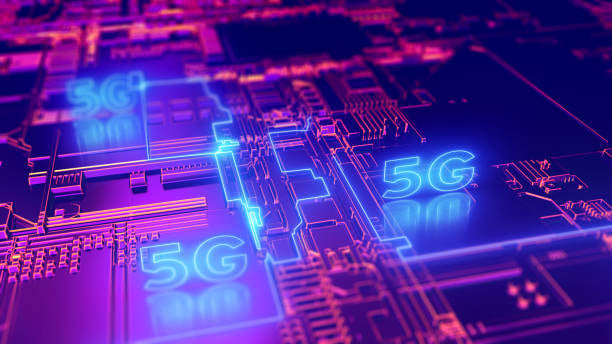Share this
Low vs. Mid vs. High 5G Frequency Bands: What's the Difference?
by Christopher Trick on Nov 17, 2022 8:02:10 AM

Within the world of 5G, devices communicate with one another via radio waves, which are carved up into sections called frequency bands. These bands, however, vary in speed and coverage.
In this blog, you'll learn about the types of 5G frequency bands, how they differ, and how Trenton's solutions support these bands to enhance computing at the edge.
What are 5G frequency bands?
With the technological landscape becoming increasingly interconnected, the ability to communicate between devices is critical.
Devices communicate via radio waves, which are forms of electromagnetic radiation that transfer data. These radio waves are divided up into frequency bands.
There are three frequency bands: low-band, mid-band, and high-band. Each of these bands has different capabilities (More on that later).
Why are 5G frequency bands important?
5G frequency bands can be used within private 5G networks to provide the best service depending on the environment and distance from the source signals, helping to eliminate dead zones.
Many materials can reflect or block high-frequency signals, but 5G technology can circumvent this by transmitting across the high-, mid-, and low-band ranges.
5G frequency bands also use frequencies across the three bands to optimize performance and can even use multiple frequencies at the same time.
This, in turn, makes 5G frequency bands more flexible than 3G or 4G bands and, as a result, increases coverage and reliability.
What are the different types of 5G frequency bands?
As mentioned earlier, there are three 5G frequency bands: low-band, mid-band, and high-band. Each band provides both outdoor and indoor coverage.
At a high level, low-bands have greater coverage but lower speeds, mid-bands have a balance of coverage and speed, and high-bands have higher speeds but less coverage.
In addition, each band presents opportunities for a service provider to balance between frequency, coverage, quality, latency, and reliability.
Spectrum availability will vary between different countries and regions in terms of bands, amounts, and timing.
Let's take a look at each in a little more detail:
Low-band 5G
Low-band 5G has a frequency range of 600 MHz to 700 MHz, and it provides coverage across a large area.
But this band also has lower speeds of around 50 Mbps.
Mid-band 5G
High-band 5G
High-band 5G can operate at 24GHz and above, providing incredibly fast speeds ranging from 1 Gbps to 10 Gbps.
But this band can only transmit data across short distances, limiting its coverage.
 At a high level, low-bands have greater coverage but lower speeds, mid-bands have a balance of coverage and speed, and high-bands have higher speeds but less coverage.
At a high level, low-bands have greater coverage but lower speeds, mid-bands have a balance of coverage and speed, and high-bands have higher speeds but less coverage.
What are some use cases for 5G frequency bands?
Users across various sectors depend on varying levels of connectivity and speed. This requires different 5G spectrum bands.
To support the needs of different users, network operators use network slicing to create independent, virtual network slices from a single shared physical network.
In addition, spectrum licensing limits activity on any one spectrum band to avoid interference and maximize efficiency.
Let's take a look at use cases for each 5G spectrum band:
Low-band use cases
Low-band 5G can be used to send small amounts of data from many distributed devices to a network and from a network back to these devices.
This holds especially true for covering wide outdoor spaces and transmitting data deep into an indoor environment.
Low-band 5G is commonly used for monitoring in rural areas and communication between indoor and outdoor machines.
Other use cases include IoT devices, smart cities, logistics, and smart agriculture.
Mid-band use cases
Mid-band 5G can be used to quickly transmit data across large areas, providing a balance between coverage and speed, and it can still be used within both indoor and outdoor environments.
Higher speed means lower latency, which, in turn, means mid-band 5G can handle more data than low-band 5G.
This proves to be especially useful for 5G use cases like enhanced mobile broadband (eMBB) and Ultra Reliable Low Latency Communications as well as autonomous vehicles.
Other use cases include media and entertainment, health, smart cities, and smart agriculture.
High-band use cases
High-band 5G offers the fastest data transfer speeds, but the coverage area is very limited. This offers incredibly high performance with low latency, but within a very targeted area.
This proves to be especially useful for artificial intelligence (AI) and edge computing applications, where massive amounts of data need to be processed, analyzed, encrypted, and delivered to users within a matter of seconds.
Other use cases include media and entertainment, manufacturing, automotive, and retail.
How can you access 5G frequency bands?
No equipment is needed to access 5G frequency bands, as the 5G network automatically switches between bands during transmission.
Additionally, many 5G devices have more than one antenna to support multiple bands.
5G frequency bands and Trenton Systems
At Trenton Systems, our 5G-powered high-performance computing solutions, in rack mount or small form factor, support all 5G frequency bands, providing the appropriate amount of coverage and speed based on user needs.
Equipped with increased data transfer rates and low latency provided by 5G connectivity, our systems help enhance applications like C6ISR, JADC2, and SIGINT at the edge in real-time within harsh environments.
This means critical insights can be delivered to military personnel across various domains within a matter of seconds, increasing situational awareness and, as a result, enabling them to effectively detect, track, and engage with enemy threats.

Final thoughts
With varying levels of speed and coverage, low-, mid-, and high- 5G frequency bands provide users across the commercial, military, and industrial sectors with the tools they need to tackle complex, demanding workloads in various environments.
These frequency bands can also adapt to performance requirements, as networks can switch between frequencies, and multiple frequencies can be used simultaneously.
Across the multi-domain battlespace, 5G frequency bands give our warfighters the flexibility to quickly adapt to their surroundings and respond to enemy threats.
Want to learn how we can help craft a custom computing solution that supports 5G technology, including frequency bands? Reach out to us anytime here.
We'd be happy to help. 😎
Interested in learning more about 5G? Check out some other key 5G technologies that enhance compute architectures here.
Sources:Share this
- High-performance computers (42)
- Military computers (38)
- Rugged computers (32)
- Cybersecurity (25)
- Industrial computers (25)
- Military servers (24)
- MIL-SPEC (20)
- Rugged servers (19)
- Press Release (17)
- Industrial servers (16)
- MIL-STD-810 (16)
- 5G Technology (14)
- Intel (13)
- Rack mount servers (12)
- processing (12)
- Computer hardware (11)
- Edge computing (11)
- Rugged workstations (11)
- Made in USA (10)
- Partnerships (9)
- Rugged computing (9)
- Sales, Marketing, and Business Development (9)
- Trenton Systems (9)
- networking (9)
- Peripheral Component Interconnect Express (PCIe) (7)
- Encryption (6)
- Federal Information Processing Standards (FIPS) (6)
- GPUs (6)
- IPU (6)
- Joint All-Domain Command and Control (JADC2) (6)
- Server motherboards (6)
- artificial intelligence (6)
- Computer stress tests (5)
- Cross domain solutions (5)
- Mission-critical servers (5)
- Rugged mini PCs (5)
- AI (4)
- BIOS (4)
- CPU (4)
- Defense (4)
- Military primes (4)
- Mission-critical systems (4)
- Platform Firmware Resilience (PFR) (4)
- Rugged blade servers (4)
- containerization (4)
- data protection (4)
- virtualization (4)
- Counterfeit electronic parts (3)
- DO-160 (3)
- Edge servers (3)
- Firmware (3)
- HPC (3)
- Just a Bunch of Disks (JBOD) (3)
- Leadership (3)
- Navy (3)
- O-RAN (3)
- RAID (3)
- RAM (3)
- Revision control (3)
- Ruggedization (3)
- SATCOM (3)
- Storage servers (3)
- Supply chain (3)
- Tactical Advanced Computer (TAC) (3)
- Wide-temp computers (3)
- computers made in the USA (3)
- data transfer (3)
- deep learning (3)
- embedded computers (3)
- embedded systems (3)
- firmware security (3)
- machine learning (3)
- Automatic test equipment (ATE) (2)
- C6ISR (2)
- COTS (2)
- COVID-19 (2)
- CPUs (2)
- Compliance (2)
- Compute Express Link (CXL) (2)
- Computer networking (2)
- Controlled Unclassified Information (CUI) (2)
- DDR (2)
- DDR4 (2)
- DPU (2)
- Dual CPU motherboards (2)
- EW (2)
- I/O (2)
- Military standards (2)
- NVIDIA (2)
- NVMe SSDs (2)
- PCIe (2)
- PCIe 4.0 (2)
- PCIe 5.0 (2)
- RAN (2)
- SIGINT (2)
- SWaP-C (2)
- Software Guard Extensions (SGX) (2)
- Submarines (2)
- Supply chain security (2)
- TAA compliance (2)
- airborne (2)
- as9100d (2)
- chassis (2)
- data diode (2)
- end-to-end solution (2)
- hardware security (2)
- hardware virtualization (2)
- integrated combat system (2)
- manufacturing reps (2)
- memory (2)
- mission computers (2)
- private 5G (2)
- protection (2)
- secure by design (2)
- small form factor (2)
- software security (2)
- vRAN (2)
- zero trust (2)
- zero trust architecture (2)
- 3U BAM Server (1)
- 4G (1)
- 4U (1)
- 5G Frequencies (1)
- 5G Frequency Bands (1)
- AI/ML/DL (1)
- Access CDS (1)
- Aegis Combat System (1)
- Armed Forces (1)
- Asymmetric encryption (1)
- C-RAN (1)
- COMINT (1)
- Cloud-based CDS (1)
- Coast Guard (1)
- Compliance testing (1)
- Computer life cycle (1)
- Containers (1)
- D-RAN (1)
- DART (1)
- DDR5 (1)
- DMEA (1)
- Data Center Modular Hardware System (DC-MHS) (1)
- Data Plane Development Kit (DPDK) (1)
- Defense Advanced Research Projects (DARP) (1)
- ELINT (1)
- EMI (1)
- EO/IR (1)
- Electromagnetic Interference (1)
- Electronic Warfare (EW) (1)
- FIPS 140-2 (1)
- FIPS 140-3 (1)
- Field Programmable Gate Array (FPGA) (1)
- Ground Control Stations (GCS) (1)
- Hardware-based CDS (1)
- Hybrid CDS (1)
- IES.5G (1)
- ION Mini PC (1)
- IP Ratings (1)
- IPMI (1)
- Industrial Internet of Things (IIoT) (1)
- Industry news (1)
- Integrated Base Defense (IBD) (1)
- LAN ports (1)
- LTE (1)
- Life cycle management (1)
- Lockheed Martin (1)
- MIL-S-901 (1)
- MIL-STD-167-1 (1)
- MIL-STD-461 (1)
- MIL-STD-464 (1)
- MOSA (1)
- Multi-Access Edge Computing (1)
- NASA (1)
- NIC (1)
- NIC Card (1)
- NVMe (1)
- O-RAN compliant (1)
- Oil and Gas (1)
- Open Compute Project (OCP) (1)
- OpenRAN (1)
- P4 (1)
- PCIe card (1)
- PCIe lane (1)
- PCIe slot (1)
- Precision timestamping (1)
- Product life cycle (1)
- ROM (1)
- Raytheon (1)
- Remotely piloted aircraft (RPA) (1)
- Rugged computing glossary (1)
- SEDs (1)
- SIM Card (1)
- Secure boot (1)
- Sensor Open Systems Architecture (SOSA) (1)
- Small form-factor pluggable (SFP) (1)
- Smart Edge (1)
- Smart NIC (1)
- SmartNIC (1)
- Software-based CDS (1)
- Symmetric encryption (1)
- System hardening (1)
- System hardening best practices (1)
- TME (1)
- Tech Partners (1)
- Total Memory Encryption (TME) (1)
- Transfer CDS (1)
- USB ports (1)
- VMEbus International Trade Association (VITA) (1)
- Vertical Lift Consortium (VLC) (1)
- Virtual machines (1)
- What are embedded systems? (1)
- Wired access backhaul (1)
- Wireless access backhaul (1)
- accredidation (1)
- aerospace (1)
- air gaps (1)
- airborne computers (1)
- asteroid (1)
- authentication (1)
- autonomous (1)
- certification (1)
- cognitive software-defined radios (CDRS) (1)
- command and control (C2) (1)
- communications (1)
- cores (1)
- custom (1)
- customer service (1)
- customer support (1)
- data linking (1)
- data recording (1)
- ethernet (1)
- full disk encryption (1)
- hardware monitoring (1)
- heat sink (1)
- hypervisor (1)
- in-house technical support (1)
- input (1)
- integrated edge solution (1)
- international business (1)
- licensed spectrum (1)
- liquid cooling (1)
- mCOTS (1)
- microelectronics (1)
- missile defense (1)
- mixed criticality (1)
- moving (1)
- multi-factor authentication (1)
- network slicing (1)
- neural networks (1)
- new headquarters (1)
- next generation interceptor (1)
- non-volatile memory (1)
- operating system (1)
- output (1)
- outsourced technical support (1)
- post-boot (1)
- pre-boot (1)
- private networks (1)
- public networks (1)
- radio access network (RAN) (1)
- reconnaissance (1)
- rugged memory (1)
- secure flash (1)
- security (1)
- self-encrypting drives (SEDs) (1)
- sff (1)
- software (1)
- software-defined radios (SDRs) (1)
- speeds and feeds (1)
- standalone (1)
- storage (1)
- systems (1)
- tactical wide area networks (1)
- technical support (1)
- technology (1)
- third-party motherboards (1)
- troposcatter communication (1)
- unlicensed spectrum (1)
- volatile memory (1)
- vpx (1)
- zero trust network (1)
- January 2025 (1)
- November 2024 (1)
- October 2024 (1)
- August 2024 (1)
- July 2024 (1)
- May 2024 (1)
- April 2024 (3)
- February 2024 (1)
- November 2023 (1)
- October 2023 (1)
- July 2023 (1)
- June 2023 (3)
- May 2023 (7)
- April 2023 (5)
- March 2023 (7)
- December 2022 (2)
- November 2022 (6)
- October 2022 (7)
- September 2022 (8)
- August 2022 (3)
- July 2022 (4)
- June 2022 (13)
- May 2022 (10)
- April 2022 (4)
- March 2022 (11)
- February 2022 (4)
- January 2022 (4)
- December 2021 (1)
- November 2021 (4)
- September 2021 (2)
- August 2021 (1)
- July 2021 (2)
- June 2021 (3)
- May 2021 (4)
- April 2021 (3)
- March 2021 (3)
- February 2021 (8)
- January 2021 (4)
- December 2020 (5)
- November 2020 (5)
- October 2020 (4)
- September 2020 (4)
- August 2020 (6)
- July 2020 (9)
- June 2020 (11)
- May 2020 (13)
- April 2020 (8)
- February 2020 (1)
- January 2020 (1)
- October 2019 (1)
- August 2019 (2)
- July 2019 (2)
- March 2019 (1)
- January 2019 (2)
- December 2018 (1)
- November 2018 (2)
- October 2018 (5)
- September 2018 (3)
- July 2018 (1)
- April 2018 (2)
- March 2018 (1)
- February 2018 (9)
- January 2018 (27)
- December 2017 (1)
- November 2017 (2)
- October 2017 (3)
/Trenton%20Systems%20Circular%20Logo-3.png?width=50&height=50&name=Trenton%20Systems%20Circular%20Logo-3.png)
No Comments Yet
Let us know what you think